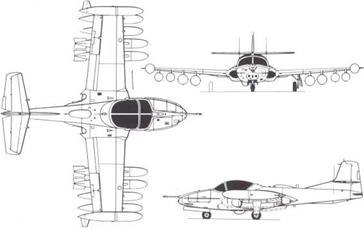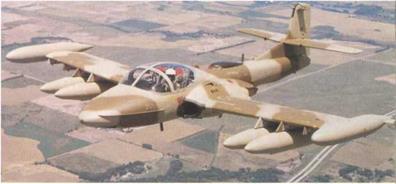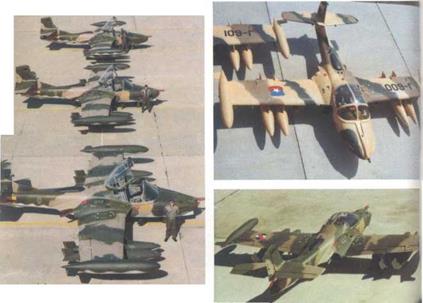Cessna A-37 Dragonfly
A-37, -37A and -37B ( Model 318E)
(data for -37B)
Origin: Cessna Aircraft Co, USA,
Type: Two-seat light strike aircraft.
Engines: Two 2.850lb (1293kg) thrust General Electric J85-17A singleshaft turbojets.
Dimensions: Span (over tip tanks) 35ft Ю^іп (1093m); length (not including refuelling probe) 29ft Зіп (8-92m); height 8ft 10Jin (2-7m). Weights: Empty 6,2111b (2817kg): loaded 14,0001b (6350kg). Performance: Maximum speed 507mph (816km/h) at 16,000ft (4875m): initial climb at gross weight 6,990ft (2130m)/min: service ceiling 41,765ft (12,730m): range (maximum weapons) 460 miles (740km), (maximum fuel) 1,012 miles (1628km).
Armament: One 7-62mm GAU-2B/A six-barrel Minigun in nose: eight wing pylon stations, two inners for up to 870lb (394kg), intermediate for 600lb (272kg) and outers for 500lb (227kg): maximum ordnance load 5,6801 b (2576kg).
History: First flight (XT-37) 12 October 1954: (YAT-37D) 22 October 1963: (A-37B) September 1967.
Users: (T-37) Brazil, Burma, Cambodia. Chile, Colombia, W Germany, Greece. Jordan, Pakistan, Peru, Portugal, Thailand, Turkey, US Air Force, Vietnam; (A-37) Brazil, Chile, Ecuador, Ethiopia (delivery embargoed at time of writing), Guatemala, Honduras, Peru, Uruguay, US Air Force and National Guard, Vietnam (left by US forces).
Development: The Cessna Model 318 was the first American jet trainer. It entered production for the US Air Force as the T-37A, powered by two 920lb (417kg) thrust Continental J69 (licence-built Turbomeca Marbore) engines and with side-by-side ejection seats. All A models were subse-
Below: The A-37B Dragonfly has been sold to numerous air forces, especially those of South America. These are aircraft of (left) the Fuerza Аёгеа Ecuatoriana, (upper right) the Fuerza Aerea de Chile and (lower right) the Fuerza Aerea Uruguayana.
|
|
|
![]()

Three-view of A-37B Dragonfly, showing the almost grotesque array of possible stores.
 |
quently converted to the standard of the main production type, the T-37B, with J69-25 engines of 1,0251b (465kg) thrust. Export versions were designated T-37C, with provision for underwing armament. Production of the T-37 was completed in 1975 with more than 1,300 delivered to the USAF and 14 other air forces. It was logical to fit the much more powerful J85 engine and restress the airframe to carry greater loads in arduous combat duties. The work began in 1960 at the time of the upsurge of interest in Со-In (counter-insurgency) aircraft to fight "brushfire wars". Deliveries of A-37A aircraft converted from T-37 trainers began in May 1967 and a squadron of 25 had flown 10,000 combat missions in Vietnam in an extensive evaluation by early 1 968. The slightly more powerful A-37B is the definitive production version and by 1977 deliveries had exceeded 600. The A-37B is not pressurised, nor does it have ejection seats, but the dual pilots are protected by layered nylon flak curtains. The wealth of nav/com avionics and possible underwing stores is impressive and nearly all В models have a fixed nose refuelling probe.
Above: Yet another of the Latin American air arms to rely on the warlike Cessna is the Fuerza Aerea del Peru. A total of 36 are in service, all flown by Grupos 13 and 21 from the major FAP base at Chiclayo. Peru’s difficulties in procuring later attack aircraft from Western sources caused it to select the Sukhoi Su-22, which when delivered lacked adequate nav/attack avionics.











